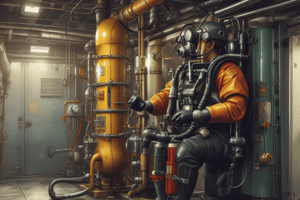Podcast
Questions and Answers
What are the three sources that can supply the B737NG air system?
What are the three sources that can supply the B737NG air system?
- Engines, APU, or ground air source (correct)
- Engines, APU, or hydraulic system
- Engines, electrical system, or external air source
- Engines, hydraulic system, or ground air source
What systems rely on bleed air?
What systems rely on bleed air?
- Anti-lock brakes, fuel tanks, and landing gear
- Air conditioning, anti-icing, and hydraulic reservoirs (correct)
- Navigation systems, communication systems, and fuel gauges
- Oxygen systems, emergency lighting, and flight controls
At what stages of the compressor section is engine bleed air obtained?
At what stages of the compressor section is engine bleed air obtained?
- 1st and 3rd stages
- 2nd and 4th stages
- 5th and 9th stages (correct)
- 7th and 8th stages
What regulates the pressure of engine bleed air and shuts off if temperature/pressure exceeds limit?
What regulates the pressure of engine bleed air and shuts off if temperature/pressure exceeds limit?
What is the function of the engine bleed air valve?
What is the function of the engine bleed air valve?
What illuminates the BLEED TRIP OFF light?
What illuminates the BLEED TRIP OFF light?
What closes the engine bleed air valve if temperature/pressure exceeds limit?
What closes the engine bleed air valve if temperature/pressure exceeds limit?
What is the purpose of the isolation valve?
What is the purpose of the isolation valve?
What provides indications to the bleed air duct pressure indicator?
What provides indications to the bleed air duct pressure indicator?
What is the purpose of the ram air system?
What is the purpose of the ram air system?
What is the function of the air conditioning packs?
What is the function of the air conditioning packs?
How many zones does the air conditioning system have?
How many zones does the air conditioning system have?
How is zone temperature controlled in the air conditioning system?
How is zone temperature controlled in the air conditioning system?
What happens if the primary flight deck temperature control fails?
What happens if the primary flight deck temperature control fails?
What reduces the air conditioning system pack load and the engine bleed air demand?
What reduces the air conditioning system pack load and the engine bleed air demand?
What is the purpose of the pressurization system?
What is the purpose of the pressurization system?
What is the function of the cabin pressure control system?
What is the function of the cabin pressure control system?
What is the purpose of the outflow valve and overboard exhaust valve in the pressurization system?
What is the purpose of the outflow valve and overboard exhaust valve in the pressurization system?
Flashcards are hidden until you start studying
Study Notes
- Bleed air can be supplied by engines, APU, or external air source
- Air conditioning, anti-icing, engine starting, hydraulic reservoirs, water tank pressurization, and nitrogen generation systems rely on bleed air
- Engine bleed air is obtained from 5th and 9th stages of compressor section
- Engine bleed air valve regulates pressure and shuts off if temperature/pressure exceeds limit
- Bleed trip sensors close engine bleed air valve if temperature/pressure exceeds limit
- Duct pressure transmitters provide indications to the bleed air duct pressure indicator
- Isolation valve isolates left and right sides of bleed air duct during normal operations
- APU bleed air valve permits APU bleed air flow to the bleed air duct
- Ram air system provides cooling air for heat exchangers
- Pack temperature control is achieved through electronic controllers and standby pack control is available in case of failure
- The air conditioning system has three zones: flight deck, forward passenger cabin, and aft passenger cabin.
- The packs produce air temperature to satisfy the zone which requires the most cooling.
- Zone temperature is controlled by introducing the proper amount of trim air to the zone supply ducts.
- Failure of the primary flight deck temperature control will cause an automatic switch to the backup control.
- Any failure affecting the supply of trim air will cause the temperature control system to control both packs independently.
- The passenger cabin air supply distribution system consists of the mix manifold, sidewall risers, and an overhead distribution duct.
- The recirculation fan system reduces the air conditioning system pack load and the engine bleed air demand.
- The equipment cooling system cools electronic equipment in the flight deck and the E & E bay.
- A ground air conditioning source may be connected to the mix manifold to distribute preconditioned air throughout the airplane.
- Cabin altitude is normally rate-controlled by the cabin pressure controller up to a cabin altitude of 8,000 feet.
- The pressurization system uses an outflow valve and overboard exhaust valve to control cabin air.
- The AUTO system has two identical controllers, with one as primary and the other as backup.
- The AUTO system presets FLT ALT and LAND ALT for the controllers to maintain cabin altitude.
- The controller maintains a proportional pressure differential between airplane and cabin altitude.
- The AUTO system activates cruise mode and descent mode based on selected altitudes.
- The AUTO system has an AUTO FA=L light to indicate faults or excessive pressure changes.
- The ALTN mode is activated if the AUTO system fails, and the MANUAL mode is for non-normal situations.
- The MANUAL mode allows the flight crew to manually control the outflow valve with a DC motor.
- The MANUAL mode can produce rapid changes in cabin pressure, causing discomfort or injury.
- The pressurization system helps passengers and crew adjust to changes in altitude during flight.
Studying That Suits You
Use AI to generate personalized quizzes and flashcards to suit your learning preferences.




